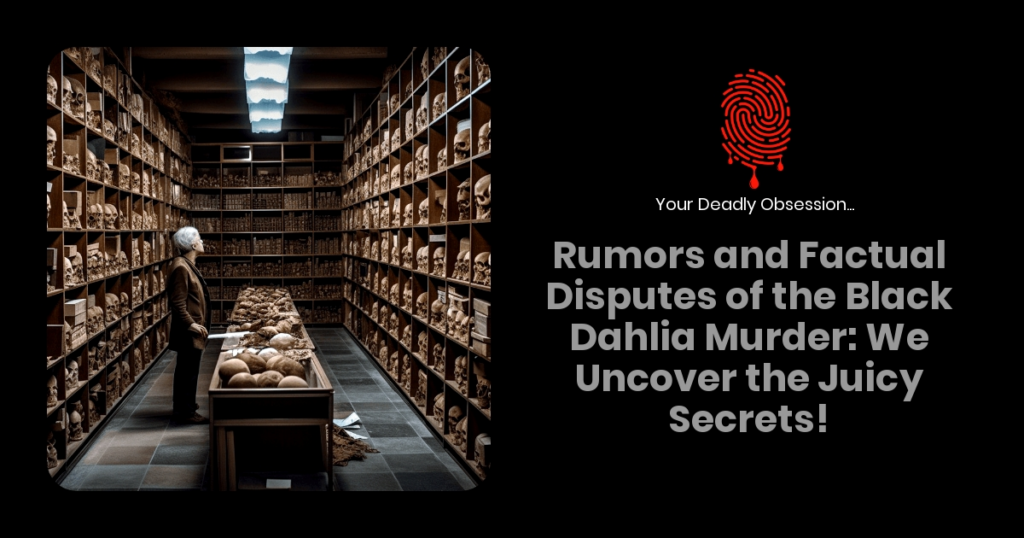We’ve all heard the chilling tales and notorious stories surrounding the Black Dahlia murder. This unsolved case has captivated the world’s attention for decades, and with good reason. As we delve into the rumors and factual disputes of this infamous crime, we’ll explore the many controversies and theories that continue to surround it.

Some of the most intriguing aspects of the Black Dahlia case are the various rumors and legends that have circulated throughout the years. They range from possible suspects to wild theories concerning the involvement of powerful, influential figures. It’s these enticing pieces of information that still regularly make headlines and fuel the ongoing fascination with the case.
However, with fame comes the inevitable mixture of fact and fiction, and the Black Dahlia murder is no exception. Throughout our journey, we will attempt to sift through the numerous claims and suspicious narratives that have emerged over the years, in the hopes of bringing clarity, or at least a bit more understanding, to this enduring mystery. So, join us as we navigate the murky waters of the Black Dahlia’s dark story!
Debunking the Top Black Dahlia Myths
Alright, let’s dive into some of the most popular myths surrounding the Black Dahlia murder case and set the record straight. As die-hard fans of cold cases and crime mysteries, we’re always eager to separate fact from fiction.
One of the most prevalent myths is that Elizabeth Short, the victim, was an aspiring actress who came to Hollywood to pursue a career in the film industry. While it’s true that she moved to California, there’s no evidence she sought an acting career. Instead, her primary objective seemed to be reconnecting with her father, whom she believed lived in the area.
Another common misconception is Elizabeth’s nickname, the Black Dahlia, stemmed from her wearing black clothing and the dahlia flower in her hair. In reality, she didn’t actually gain the moniker until after her death. Newspapers came up with the nickname, likely inspired by a film noir released at the time called The Blue Dahlia. Elizabeth frequently wore black clothing, but there’s no record of her regularly wearing dahlias in her hair.
Many conspiracy theories surrounding the case involve the idea that the murderer was a surgeon or doctor due to the gruesome nature and precision of the mutilation. While it’s true that the dismemberment of Short’s body was carried out with skill, this doesn’t definitively link it to a medical professional, and no concrete evidence directly ties a specific doctor or surgeon to the case.
There’s even a bit of confusion around how Elizabeth was identified following her murder. Some sources claim that her fingerprints had already been on file with the FBI due to a previous arrest. However, Elizabeth’s fingerprints were actually collected by the US Navy when she applied for a clerical job during World War II. Those were the prints used to confirm her identity.
To sum up the myths we’ve debunked:
- Elizabeth Short wasn’t pursuing an acting career
- The “Black Dahlia” nickname originated from newspapers after her death
- There’s no conclusive evidence linking a doctor or surgeon to the crime
- Elizabeth’s fingerprints were on file with the US Navy, not the FBI
As we continue to explore the Black Dahlia case, it’s crucial to separate fact from fiction so we can properly analyze and draw conclusions while also honoring the memory of Elizabeth Short.

Separating Fact from Fiction in the Press
When it comes to the Black Dahlia murders, we’ve all heard countless rumors and disputable facts swirling around. It’s essential to examine which of these claims hold water and which are purely speculative. So, let’s dive into separating fact from fiction when it comes to the press coverage regarding this mysterious case.
We’ve seen many publications focusing on Elizabeth Short’s personal life leading up to her tragic end, offering insights into her relationships and possible motives behind her murder. However, some of these claims are either exaggerated or entirely false.
- One rumor claimed Elizabeth lived a promiscuous lifestyle; in reality, the FBI’s investigation revealed that she had very few, if any, romantic entanglements before her death.
- Another common assertion is that she was an aspiring actress looking for her big break in Hollywood. While it’s true she wanted to pursue a career in acting, there’s no concrete evidence to suggest she ever actively sought a role.
Of course, the meat of the discussion is the countless murder theories that have circulated in the press.
- Some have suggested that the murder was the work of the Cleveland Torso Murderer, but without sufficient evidence, this remains purely speculative.
- Another notable theory hints at the involvement of Dr. George Hodel, a physician with links to the LAPD. Despite continued interest in this theory, definitive proof is still lacking.
In some cases, the press has leaked misleading “evidence” that’s later debunked.
| Misleading Evidence | Debunked Reason |
|---|---|
| A blood-soaked purse | Had no connection to the case |
| Elizabeth’s friend’s confession | Story contradicted by police records |
We understand people’s fascination with this tragic and unsolved case, but it’s crucial to separate fact from fiction when discussing the Black Dahlia murders. While it’s tempting to cling to intriguing theories and rumors, it’s important to dig deeper and examine the credibility of these claims.
Now that we’ve laid out some of the more notable rumors, disputes, and factual disputes surrounding the case, we hope this will help readers like us who love cold cases, crime, and mystery to differentiate between fact and fiction in the widely discussed Black Dahlia murders.
Key Players and Their Suspected Involvement
Let’s dive into the key players and their suspected involvement in the Black Dahlia murder case. The murder of Elizabeth Short, also known as the Black Dahlia, has intrigued mystery and true crime enthusiasts for decades since her gruesome death in 1947. Numerous suspects have emerged over the years, with some more plausible than others.
First on our list is Dr. George Hodel, a prominent Los Angeles physician. His son, Steve Hodel, a former LAPD homicide detective, has written books and gathered evidence pointing to his father’s involvement in Short’s murder. Some key points include:
- A secret room in Dr. Hodel’s house that allegedly contained documents and photos related to the case
- Abuse allegations from another of his children
- Medical knowledge and surgical precision, which could have been used to dismember Short’s body
We also have Leslie Dillon, a bellhop and aspiring writer. Here’s why some people suspect him:
- A fellow bellhop, Jeff Connors, told police that Dillon was fascinated by the murder and even wrote a detailed screenplay about it
- Dillon claimed to have met the actress before her death
- He was also said to have had an alibi for the time of the murder, but this alibi has been questioned
Another suspect is Walter Bayley, a surgeon who lived near the crime scene. Curiously, he:
- Had a strained relationship with his own family
- Was friends with Short’s father and neighbored his ex-wife
- Demonstrated surgical skills in his profession that could link him to the case
Let’s not forget George “Bugs” McGurn, a known mobster at the time. It’s rumored that:
- Short may have had a relationship with a mobster, potentially McGurn
- Mob involvement may help explain the gruesome nature of the crime
Lastly, we’ve got Red Manley, a traveling salesman who had spent time with Short shortly before her death. Manley:
- Was one of the last people to see Short alive
- Became a suspect due to his proximity to the victim
- Eventually passed a polygraph test and was cleared
In our pursuit for the truth, we must remember that despite the numerous suspects, no one was ever charged with the murder of Elizabeth Short. Nonetheless, cold case enthusiasts continue to explore new leads and possible connections in the hope of someday solving this notorious mystery.
The Role of Forensic Science in Resolving Rumors
Forensic science has played a significant role in debunking various rumors surrounding the Black Dahlia murder. Let’s take a closer look at how some of these rumors have been discredited.
One of the most persistent rumors revolves around the killer’s identity. Several individuals have come forward or have been accused – celebrities, mafia members, and even family members. Thanks to advancements in forensic science, we’ve been able to examine and rule out many of these suspects.
- DNA evidence has become increasingly reliable in solving cold cases. Even though the Black Dahlia case lacks contemporary DNA evidence, any new claims of guilt can be tested and scrutinized using DNA databases.
- Forensic analysis of physical evidence, such as fibers and hairs, can help exclude suspects who don’t match the crime scene evidence.
Another common rumor involves the idea that the crime scene was staged. People have argued that the victim, Elizabeth Short, was posed in a specific way to send a message or as an homage to a certain artwork. Forensic science sheds light on this by providing:
- Blood spatter pattern analyses, which can differentiate between random positioning of a body and intentional staging.
- Trauma analysis, revealing the sequence of injuries and giving clues about the intent behind various actions.
One major factual dispute involves the extent of mutilation. There have been wild claims about the nature of the injuries inflicted upon Short’s body. Forensic science has helped us better understand the true extent of her injuries:
| Injury Claim | Forensic Finding |
|---|---|
| Body bisected | TRUE |
| Dismemberment | FALSE |
| Facial mutilation | TRUE |
Lastly, forensic science continues to provide insights on the timeline and events leading up to her death. For example:
- Meticulous examination of her stomach contents can give a clearer picture of her whereabouts and activities shortly before her murder.
- Analysis of pollen and soil evidence hitched on her body can help narrow down transportation and location details.
In the end, it’s important to avoid falling into the trap of sensationalism and stick to the FACTS. Through forensic science, we can clear away the fog of rumors and focus on the truth, bringing us closer to unraveling the mystery of the Black Dahlia murder. No matter how much time has passed, forensic science remains a vital tool in our continuous quest for justice.
Sordid Details and the Truth Behind the Crime Scene
Let’s dive right into the rumors and factual disputes that have swirled around the Black Dahlia murder case. We’ll try to make sense of the confusing details and separate fact from fiction.
- The Crime Scene: It’s said that the grim discovery of Elizabeth Short’s body was staged for maximum shock value. Her corpse was severed in half, drained of blood, and posed in a gruesome manner. While there’s truth to this, we should bear in mind that the perpetrator wanted not only to murder but also to instill terror.
- Initial Suspects: Several people were investigated as possible suspects in the case. However, only one piqued the interest of the police – Dr. George Hodel. There were rumors that he had an intimate relationship with Short and that this connection led to her untimely death.
Table: Notable Suspects
| Name | Relation to Short | Rumors |
|---|---|---|
| Dr. George Hodel | Alleged intimate relationship | Fled to the Philippines after the murder |
- Mafia Involvement: Word spread that the mafia was somehow connected to the Black Dahlia’s murder. Links between Short and gangsters were explored, but nothing concrete surfaced. It’s essential to mention that despite the rumors, there is no solid evidence tying the mob to the crime.
- Confessions: Over the years, countless people have confessed to being responsible for the atrocious murder. Most have been seeking attention or suffering from mental issues. The confessions have only fueled more rumors and muddied the waters about the case.
- Dr. George Hodel Revisited: Hodel’s own son, Steve, a former LAPD homicide detective, wrote a book claiming his father was the Black Dahlia’s murderer. Steve uncovered incriminating evidence, including a photograph he believed to be Elizabeth Short among his father’s possessions. However, it’s worth noting that skeptics question the validity of these claims, and some believe Steve capitalized on the infamous case to sell books.
We’ve covered some of the most talked-about rumors and disputes surrounding the Black Dahlia case. What we now know is that the case is still unsolved, and the speculation continues to captivate crime enthusiasts and amateur sleuths alike. The truth may still be buried beneath the layers of fog and mystery that long obscured this chilling crime.
What is the evidence in the Black Dahlia murder?
The Black Dahlia murder case, involving the brutal killing of Elizabeth Short in 1947, is notorious for its lack of concrete evidence. The primary evidence consists of the mutilated body of the victim, found in a vacant lot in Los Angeles, and various witness accounts. Due to the absence of definitive physical evidence or a clear motive, the case remains unsolved to this day.
Who was the main suspect for the Black Dahlia murder?
The main suspect for the Black Dahlia murder was Dr. George Hodel, a physician who lived in Los Angeles at the time of the crime. Although he was never charged, recent investigations and evidence have strengthened the case against him, making him the most likely suspect in the brutal murder of Elizabeth Short.
Conclusion: Finding Closure in the Black Dahlia Case
So, we’ve taken a deep dive into the Black Dahlia case, investigating the rumors and dissecting factual disputes. We’ve discovered new angles and reexamined old evidence. But at this point, we still face that lingering question – can we find closure in this murky, unsolved mystery?
Without a doubt, we’d all love to finally solve the puzzle that has haunted true crime enthusiasts for decades. Sadly, though, we’ve yet to uncover that single piece of undeniable proof to close the case definitively. Nevertheless, we’re left with several key takeaways from our journey.
- The passage of time: Although we may never know the true story behind the Black Dahlia murder, it’s essential we don’t forget that this case is more than just a sensational tale. Elizabeth Short was a real person, and her family has been seeking justice for her for over 70 years. It’s a sobering reminder of how time marches on and the agony of unsolved crimes.
- The evolution of investigative techniques: We can’t help but wonder if this case would have been solved had modern forensic technology been available back then. DNA testing, advanced criminal profiling, surveillance footage – all these tools might have made a significant difference. But since they didn’t exist in 1947, we’re reliant on the evidence that has survived.
- The importance of separating fact from fiction: As we’ve shown, there are countless rumors surrounding the Black Dahlia case. While it’s intriguing to explore these theories, it’s crucial not to lose sight of the facts, as it’s easy to stray into the realm of speculation.
At the end of the day, we can’t change the past or overturn the circumstances that have led to the enduring mystery of the Black Dahlia. However, we can continue to educate ourselves, follow the evidence, and respect the memory of Elizabeth Short.
And as dedicated fans of cold cases, crime, and mystery, we won’t let go of the hope that one day, the truth behind the Black Dahlia murder will be brought to light, providing closure not only for us but especially for Elizabeth and her family. Until then, we’ll be here, keeping the search for justice alive.
References:
https://www.fbi.gov/history/famous-cases/black-dahlia

Owner & entrepreneur with a passion for murder mystery! Seriously, who doesn’t love murder mystery?
Chris is a proud member of the American Medical Writer’s Association (AMWA), the International Society for Medical Publication Professionals (ISMPP), the National Association of Science Writers (NASW), the Council of Science Editors, the Author’s Guild, and the Editorial Freelance Association (EFA).

